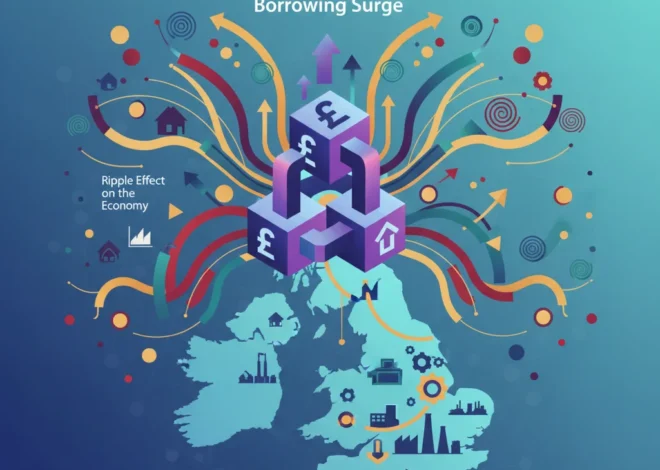
The Rental Crisis: A Canary in the Coal Mine for the Global Economy?
The Unspoken Question Reverberating Through the Economy
A simple question posed by the BBC—”What do you think about the cost of renting in Scotland?”—opens a Pandora’s box of complex economic issues that extend far beyond the cobbled streets of Edinburgh or the bustling lanes of Glasgow. On the surface, it’s a question about affordability and housing. But dig deeper, and you’ll find it’s a critical inquiry into the state of our modern economy, touching upon everything from monetary policy and inflation to the future of investing and the disruptive potential of financial technology. For investors, finance professionals, and business leaders, understanding the dynamics of a regional rental market like Scotland’s is no longer a niche concern; it’s a case study in the systemic pressures shaping global capital, labor mobility, and long-term economic stability.
The soaring cost of rent is not merely a headline; it is a powerful non-traditional economic indicator. It reflects a confluence of post-pandemic inflation, strained supply chains, shifting demographics, and a decade of accommodative monetary policy coming home to roost. As we dissect the Scottish rental market, we uncover a microcosm of the challenges facing developed economies worldwide, offering crucial insights for anyone involved in finance, banking, and strategic investment.
Macroeconomic Headwinds and the Local Squeeze
To comprehend why a two-bedroom flat in Dundee now commands a premium, we must first look at the global macroeconomic landscape. The era of near-zero interest rates is decisively over. Central banks, including the Bank of England, have engaged in aggressive monetary tightening to combat runaway inflation. This has direct and profound consequences for the housing market. Higher interest rates make borrowing more expensive, which impacts the economics of real estate from multiple angles:
- Increased Landlord Costs: Many landlords hold buy-to-let mortgages, often on an interest-only basis. As these mortgages come up for renewal, the monthly payments have skyrocketed, forcing landlords to pass these costs onto tenants to maintain profitability.
- Deterred First-Time Buyers: The same high interest rates that squeeze landlords also lock potential first-time buyers out of the market. With mortgage affordability at its lowest point in decades, a larger portion of the population is forced to rent for longer, artificially inflating demand in the rental sector.
- Construction Slowdown: The cost of capital for property developers has also surged. This, combined with high material and labor costs, has slowed the construction of new housing stock, exacerbating the chronic undersupply that plagues much of the UK. According to the Scottish Government, while there have been efforts to increase housing supply, the pace has struggled to keep up with persistent demand.
This trifecta creates a perfect storm in the rental market. We see a pincer movement of rising operational costs and surging demand, all set against a backdrop of stagnant supply. This isn’t a uniquely Scottish problem, but its effects are particularly acute in urban centers, driving a wedge between wage growth and the cost of living and posing a significant threat to the broader economy.
An Investor’s Dilemma: Navigating a Regulated and Volatile Market
For decades, residential property was considered a cornerstone of a diversified investment portfolio—a stable, income-generating asset. However, the current climate is forcing a radical reassessment of this long-held belief. Investors in the Scottish property market, and indeed across the UK, face a new set of challenges that significantly alter the risk-reward calculus.
Regulatory intervention, such as the Scottish Government’s emergency rent cap and eviction moratorium, introduced to protect tenants, has had a chilling effect on investor sentiment. While well-intentioned, these policies introduce a level of uncertainty that capital markets abhor. The potential for reduced rental yields and the inability to remove non-paying tenants has led some landlords to exit the market altogether, further shrinking the available housing pool. A report from property portal Citylets highlighted that “landlord confidence remains fragile” in the face of ongoing legislative changes.
This environment necessitates a more sophisticated approach to property investing. The days of simple buy-to-let strategies yielding easy returns are over. Today’s investor must consider:
- Alternative Real Estate Assets: Shifting focus from residential to commercial, industrial, or specialized real estate like life sciences facilities or data centers.
- Real Estate Investment Trusts (REITs): Investing in the stock market via REITs offers exposure to property with greater liquidity and diversification, mitigating the risks associated with owning physical assets directly.
- Property Development Funds: For those with a higher risk appetite, investing in the creation of new housing supply can offer significant returns, though it requires a longer time horizon and substantial capital.
The table below illustrates the stark reality of rental inflation in Scotland’s major cities, underscoring the pressures on both tenants and the investment viability of the sector.
| Scottish City | Average Time to Let (Q4 2023) | Average Monthly Rent (2-Bed Property) | Year-on-Year Rental Growth |
|---|---|---|---|
| Edinburgh | 18 Days | £1,470 | +12.2% |
| Glasgow | 16 Days | £1,213 | +11.2% |
| Dundee | 21 Days | £897 | +12.4% |
| Aberdeen | 29 Days | £801 | +7.3% |
Data synthesized from Q4 2023 market reports, illustrating the high demand and rapid price appreciation.
Can Financial Technology Offer a Way Out?
When traditional markets and policies fail, innovation often rushes in to fill the void. The intersection of finance and technology—fintech—presents several compelling, if not yet mainstream, solutions to the affordability and investment crises plaguing the housing sector. These innovations aim to democratize access to property, increase liquidity, and streamline inefficient processes.
One of the most promising areas is the tokenization of real estate assets using blockchain technology. Here’s how it works: a property’s value is converted into a series of digital tokens, which can be bought and sold on a digital marketplace. This has several revolutionary implications:
- Fractional Ownership: Instead of needing hundreds of thousands of pounds for a deposit, an individual could invest a few thousand—or even a few hundred—pounds to own a fraction of a property. This dramatically lowers the barrier to entry for real estate investing.
- Enhanced Liquidity: Selling a property can take months. Trading property tokens, in theory, could be as quick and easy as stock market trading, transforming an illiquid asset into a liquid one.
- Transparency: Blockchain’s immutable ledger provides a transparent record of ownership and transactions, reducing fraud and administrative overhead in the conveyancing process.
Beyond blockchain, other financial technology solutions are emerging. Proptech platforms are using AI to optimize property management, reducing costs for landlords. Innovative lending platforms are creating new mortgage products and rent-to-own schemes that offer tenants a pathway to ownership. While these technologies are still in their nascent stages, they represent a fundamental rethinking of the relationship between people, property, and capital. The traditional banking sector is taking note, with many institutions now exploring how to integrate these fintech solutions into their own offerings.
Petrofac's Perfect Storm: A Deep Dive into Corporate Collapse and the Future of Energy Finance
The Ripple Effect: Broader Implications for the Economy
The high cost of renting is not an isolated issue contained within the real estate sector. Its shockwaves are felt across the entire economic system. When a significant portion of a household’s income is consumed by rent, it has a chilling effect on consumer spending, which is the primary driver of GDP in most Western economies. This is a core concept in economics: reduced discretionary income means less money spent on goods, services, hospitality, and entertainment, leading to slower economic growth.
Furthermore, a dysfunctional rental market creates significant friction in the labor market. If skilled workers cannot afford to live in cities where the best job opportunities are, it leads to labor shortages in key sectors and hampers productivity. This is a direct threat to the competitiveness of cities like Edinburgh, a major financial and tech hub. The Fraser of Allander Institute has repeatedly warned that housing affordability is a key structural challenge for the Scottish economy’s long-term health.
Finally, this situation poses a systemic risk. A large population of financially precarious renters, coupled with over-leveraged landlords, creates a fragile ecosystem. Any significant economic downturn could trigger a wave of defaults, impacting not only the housing market but the balance sheets of the banks that lend to it. It’s a stark reminder that housing stability is inextricably linked to financial stability.
Anatomy of a Downfall: Petrofac's Collapse and the Hard Lessons for Investors and the Economy
Conclusion: From a Local Problem to a Global Imperative
The question of rental costs in Scotland serves as a powerful lens through which to view the profound economic shifts of our time. It’s a story of how global monetary policy, local supply constraints, and regulatory actions converge to create a crisis that affects everyone from the tenant struggling to pay rent to the institutional investor managing a global property portfolio. The old models of property investing and housing policy are proving inadequate for the challenges ahead.
The path forward requires a multi-pronged approach. Governments must focus on creating a stable policy environment that encourages the construction of new homes. The private sector, particularly the worlds of finance and fintech, must champion innovative solutions that make housing more accessible and investing more flexible. For business leaders and investors, the key takeaway is that understanding these deep-seated structural issues is no longer optional. The stability of our economies and the health of our societies depend on finding a sustainable answer to this very simple, yet incredibly complex, question.


